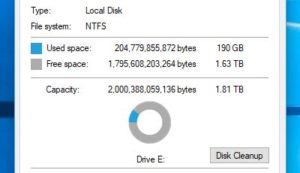You may have noticed that there is usually a discrepancy between the capacity listed on a hard drive label and the capacity reported by the computer. For instance, I attach a 250 GB hard drive into my computer and it shows as 232.74 GB available. Some of that has been lost in the formatting of the files system, but not all of it!
This can be explained with simple mathematics and the differences between base-10 and binary base-2 counting methods. Computers and operating systems typically run base-2 where a gigabyte is 1024 megabytes and a megabyte is 1024 kilobytes. Drive manufactures base their labeling and marketing on the base-10 methodology which means a gigabyte is 1000 megabytes and a megabyte is 1000 kilobytes.

Storage capacity reporting
This wasn’t really a problem until the mid 2000’s when hard drive manufactures really started to increase to availability of large capacity discs. Every gigabyte added to a hard drive caused a discrepancy of 73,741,824 bytes. Nowadays it is typical for the manufactures to overshoot on the number of bytes they can fit on a drive which ends up giving you back several gigabytes.
Windows 10 and Apple operating systems since Snow Leopard make up for the difference in numbers by calculating both readings for you and typically gives you the easier to read base-10 number first.On windows 10 in the disc properties you can see the number given in both base-2 and base-10 counting systems. In the picture above you can see that my PC is reporting my 2TB hard-drive as having just over 2 trillion bytes. You can also see the discrepancy between the actually bytes given and the GB reading. With cloud computing we are typically only given the base-10 value which ends up being fine we we typically deal with gigabyte and terabyte storage plans.
